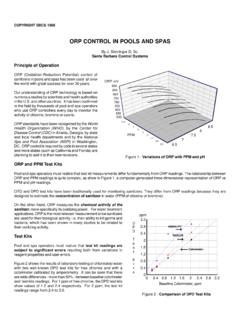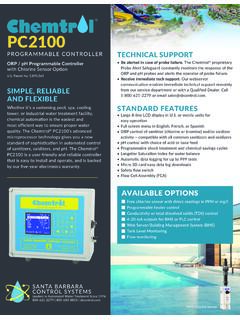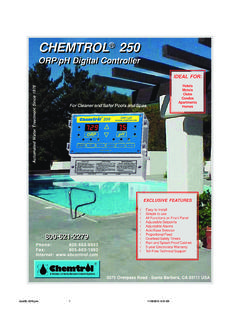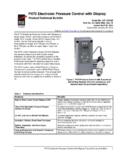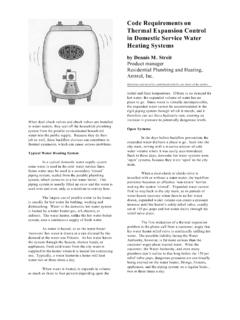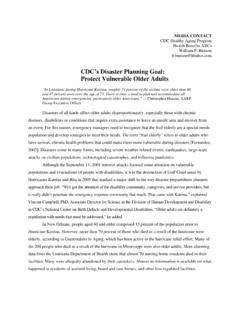Transcription of THE ORP STANDARD - CHEMTROL POOL CONTROL
1 Oxidation-reduction potential(ORP) a mandatory STANDARD formeasuring water quality in WestGermany s public pools and spas oughtto become a public-health requirementin the United States, aquatics consultantJim Brown of Beaverton, Ore., toldsanitarians at this year s NationalEnvironmental Health Associationannual , who recently completed astudy of chemical and microbiologicalwater-quality constituents for 30 publicspas in the area of Portland, Ore., toldhis listeners that he found little correlationbetween free-chlorine-residualreadings and the bacteriological qualityof the spas he surveyed. He plans topublish his findings in the Journal ofEnvironmental Health and the Archivesof Environmental Health.
2 Normally, he says, it is presumedthat if you are maintaining a free chlorineresidual of 2 milligrams, youhave good water quality, but we didnot find this to be true. The onlyparameter that seemed to take intoconsideration all the constituents including oil and grease concentration was ORP. We found that wheneverthe ORP residual was equal to orgreater than 650 millivolts, the waterwas bacteriologically acceptable. Brown, a member of the NationalSanitation Foundation (NSF) taskcommittee that is currently reviewingpool and spa equipment standards , saysthat ORP is a well-known measurementin the field of sewage waste-watertreatment.
3 People who are knowledge-able in that area are frankly surprisedthat we don t use it for pools and spas, he says. Public spas in particular area prime target for ORP, because organic loading makes potentialdisease transmission far more significantfor public spas than for pools. Brown s report suggests that batherloading, ORP and chlorine s effectivenessare directly related, says JackMoorehead of Fairchild Filter Corp.,La Jolla, Calif. The OTO chlorine test kitroutinely sold in pool stores isunreliable because it fails to distinguishbetween free and combined chlorine,By Sylvia TierstenMoorehead says. The parts-per-millionreading could reflect combinedchloramine, which wont protect bathersfrom bacteria and organic and chemicalloading drastically reduce the ability offree chlorine to overcome bacteria, DPD Free chlorine is aquantitative measure,and ppm is a measures thequalitative result.
4 Free chlorine test kits also are ofquestionable value unless the exact levelof organic contaminant in the spa watercan be determined, Moorehead West Germany s public-healthstandards, Moorehead says that pooland spa water quality in that countrymeets or exceeds EnvironmentalProtection Agency drinking waterstandards in the United States. InGermany, he explains, free chlorine levelsof .2 to .4 ppm are considered more thanadequate as long as the ORP is at anacceptable level of 650 millivolts Steininger of Santa BarbaraControl Systems, Cherntrol Division,Santa Barbara, Calif., defines ORP as the oxidation-reduction potential of asanitizer such as chlorine, bromine orozone.
5 These oxidizers burn offimpurities in the water, including bodywastes, algae and bacteria. The ORP sensor measures thepotential generated by the active form ofthe sanitizer, and not the inactive forms,such as combined chlorine. Unlike OTOor DPD eyeball testing, ORP is anongoing electronic process that requiresno test chemicals or reagents andconstantly monitors sanitation pool and spa industrypeople and public health officials to relyon ORP is a question of education,Brown says. He predicts the eventualadoption of an ORP STANDARD for publicand semi-public pool and spa probes priced in the $200-to-$300range are available and monitor wateron a continuous basis.
6 However, Brownsays that the cost of the probes wouldbasically rule out the home marketduring the next few , a handful of manufacturersproduce ORP probes, usually as acomponent of an automated chemicalfeeder system. Ironically, even managersof pools and spas who swear bychemical automation usually are unawarethat ORP metering is built intothese systems; the acronym is anythingbut a household Poirier of Ofuro Hot Tubs, SanDiego, Calif., is a case in point. Hiscommercial hot tub facility is controlledby a chlorine monitor, which he saysis a sheer necessity for any and all spasthat demand constant maintenancebecause of large or fluctuating batherloads.
7 Although the system containsan ORP probe, Poirier says that he wastotally unfamiliar with the concept orterm from health departmentswill push public pool and spa operatorsover to automation and, indirectly, toreliance on ORP, Pablo Navarro ofCherntrol says. Put four to six peoplein a 300-to-700-gallon body of water, he says, and you are immediatelytaking out a lot of the chlorine. Bynoon, the sanitizer could be gone. Hesays that ORP is probably the truestPlease turnthe national trade magazinefor the pool and spa industryTHE ORP STANDARDA better method of assuring water sanitization?POOL & SPA NEWS October 7, 1985measurement of water cleanliness.
8 Navarro tells prospective buyers that if you automate, you will save onchemical consumption. It is the waveof the future. He likens it to use ofa thermostat on a heater. If you triedto CONTROL it by hand, the temperaturewould keep swinging up and down, manufactures chemicalautomation controllers for small poolsand spas with an ORP probe forchlorine or bromine sensing but no pHcontrol. The firm also makes systemsusing both ORP and pH sensors formedium and large commercial provide direct readout in termsof pH and ppm; the millivolt readingfor ORP is converted into ppm so theaverage user can understand less expensive controllers rely onthe ORP probe to sense the chlorineor bromine level and omit pH controllingaltogether.
9 Usually, Navarro says,ORP falls whenever pH drops off ineither direction. This type of controllingis most appropriate when the moreneutral types of sanitizers are used, suchas dichloro or bromine; it is lessapplicable when liquid sodiumhypochlorite or chlorine gas sanitizers greatest barrier to acceptance ofautomated chemical feeders is cost,Navarro says. Controls retail at $625for smaller installations and up to$6,900 for larger commercial pools withautomatic weekly superchlorinationcycles. But prices will come down asthe market grows and large-scalefabrication becomes feasible, some places, chemical automationalready is mandatory.
10 In WarrenCounty, Ohio, for example, the GeneralHealth District requires installation ofan electronic water- CONTROL device onall public spas and hot tubs to monitorand CONTROL free chlorine and pH. Thesame is true in Anchorage, Alaska,where an automatic chlorinator with asensor is required to insure proper levelsof Poirier tried to open a publichot tub facility in San Diego in 1979,he found the local health department very strict and not very flexible. Ichecked around in other places such asOregon and found that there had beenproblems, he has become a proponent ofstrict regulations for the good of ourindustry.
